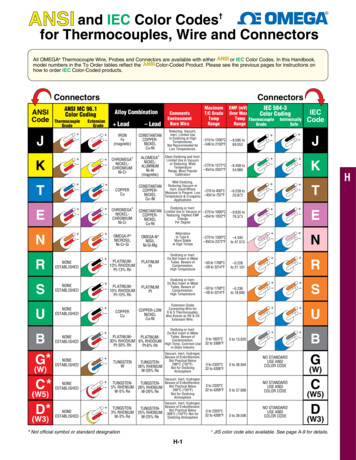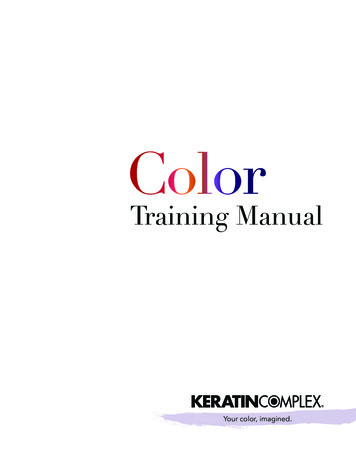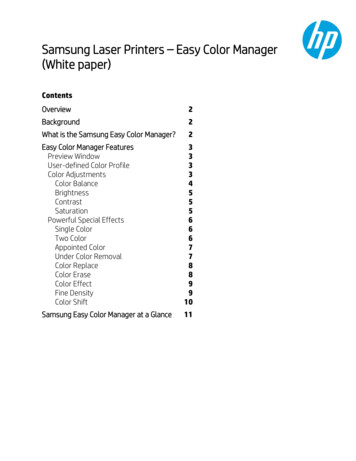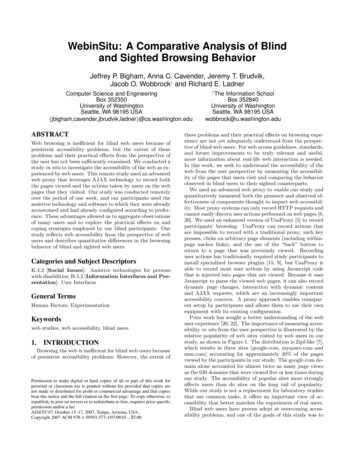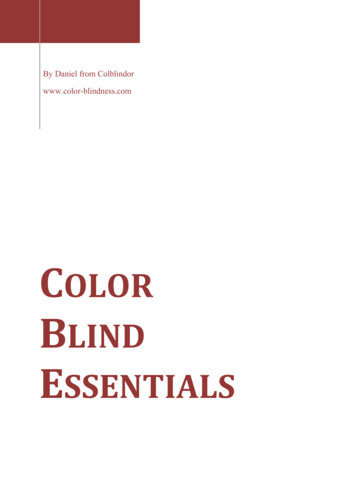
Transcription
By Daniel from ALS
COLOR BLIND ESSENTIALS2Many people are looking for the basics about color blindness. So I wrote thefollowing eBook on COLOR BLIND ESSENTIALS which should give you a good overviewover the most central topics.You will not only learn what color blindness really is, which forms of it exist and ofcourse some details about the most well known red-green color blindness. But you willalso have the possibility to read more about on how a color vision deficiency can affectyour everyday life, if there is a way to cure or at least soften it and the differentpossibilities to test your color vision.This eBook on COLOR BLIND ESSENTIALS includes the following six parts: What is color blindness?Types of color blindnessRed-green color blindnessColor blindness testsLiving with color blindnessCuring color blindnessIf you want to learn even more about color blindness and closely related topics, youcan either follow some of the links I provide in this eBook or visit my site at www.colorblindness.com which includes a lot more information and even some tools and tests forcolor vision deficiency.Visit Colblindor at www.color-blindness.com and learn a lot more about color vision deficiency,try out some tools or even take some online color blindness tests.
1 What is Color Blindness?Table of ContentsWhat is Color Blindness? . 511.1So what actually is color vision deficiency also known as color blindness? . 51.2History of color vision deficiency . 51.3The cause of color blindness . 61.4Why am I suffering from color blindness?. 61.5Color blindness inheritance pattern . 71.6Am I the only colorblind person?. 8Types of Color Blindness . 922.1How color vision works . 92.2Types of color vision deficiency . 102.3What do you see if you are colorblind?. 11Red-Green Color Blindness . 1333.1Discovery of red-green color blindness. 133.2The facts . 143.3Often confused colors . 143.4Difference between red- and green-blindness . 15Color Blindness Tests . 1744.1The first color blindness tests . 174.2Different test forms . 184.2.1Anomaloscope . 184.2.2Pseudoisochromatic plates . 184.2.3Arrangement tests . 194.2.4Lanterns . 204.3Comparison of color blindness tests . 204.4The future of color vision testing . 21Living with Color Blindness . 2255.1Color blindness in everyday life . 225.2Choosing your career as a colorblind . 23Curing Color Blindness . 2566.1First ideas . 256.2Aids for colorblind people . 266.3Cure of color vision deficiency . 27Visit Colblindor at www.color-blindness.com and learn a lot more about color vision deficiency,try out some tools or even take some online color blindness tests.3
4COLOR BLIND ESSENTIALSVisit Colblindor at www.color-blindness.com and learn a lot more about color vision deficiency,try out some tools or even take some online color blindness tests.
1 What is Color Blindness?1 What is Color Blindness?Color blindness is not ‘color blindness’! There are still a lot of people who think thatif you are colorblind you really can’t see any colors. But the term is misleading, as morethan 99% of all colorblind people can see colors. A better wording would be colorvision deficiency, which describes this visual disorder more precisely.1.1 So what actually is color vision deficiency also knownas color blindness?Simply put, if you are suffering from a color vision deficiency you perceive anarrower color spectrum compared to somebody with normal color vision.This short definition raises a few more questions which need to be answered tounderstand the term color-blind more completely: Why am I suffering from color blindness at all?What means narrower color spectrum compared to normal color vision?Are there different types of color vision deficiency?How do I know if I’m colorblind?Is there some possibility to cure color vision deficiency?Can I just live with it or do I have to be afraid of it?In the first chapter I will among other things answer the first two of those questions.The others will be looked at in the following chapters of this eBook about COLOR BLINDESSENTIALS. But first of all I would like to take you back to the 18th century 1.2 History of color vision deficiencyThe first scientific paper about color blindness was written by John Dalton in 1793entitled “Extraordinary facts relating to the vision of colours“. Dalton himself was redgreen colorblind and as a scientist he took interest in this topic. He claimed that acolored liquid inside the eyeball is the source for a different color perception. Thiswas proved wrong only after his death, when his eyes were examined and no such liquidwas found.After that Thomas Young and Hermann von Helmholtz were the first who describedthe trichromatic color vision. And once a theory for human color vision was ready, thebasics of color vision deficiency weren’t far away.Visit Colblindor at www.color-blindness.com and learn a lot more about color vision deficiency,try out some tools or even take some online color blindness tests.5
6COLOR BLIND ESSENTIALS1.3 The cause of color blindnessColor perception in the human eye is build up by three different types of cones.Each type is sensitive to a certain wavelength of light (red, green, and blue) and everyperceived color is therefore a mixture of stimuli of those three cone types.Now, if you one of those peaks of sensitivity is shifted towards another one or if oneis missing at all, you perceive a narrower color spectrum—in other words you arecolorblind. As a peak can be shifted everything between a little bit and the whole way,any type of severity is possible. The closer the peaks are the more severe is your colorvision deficiency: slightly, moderately, strongly, or absolutely colorblind.“What do you mean by «narrower color spectrum»?”Let’s say somebody with normal color vision can identify and distinguish 150 hues.If you are colorblind this number starts to drop as you have fewer possibilities to createcolor mixtures from your color receptors. In case of absolute color blindness—missingone type of cone at all—you might be able to distinguish only as many as 20 differenthues!The type of affected cones also has a big impact on your color vision deficiency. Asthere are three different types of color receptors, there are also three different mainforms: red (protan), green (deutan), and blue (tritan) disorders. As red and greendeficiency result in quite comparable color vision problems, they are often taken togetherand known as red-green color blindness. You will find more information on the typesof color blindness in the following two articles of this COLOR BLIND ESSENTIALS series.Much less common possibilities for color blindness are also glaucoma, aging, alcoholmisuse, or a hard injury on your head. Those factors often cause some milder form ofblue-yellow color blindness (tritanomaly). Also other facts like signal transmission cancause problems in color perception, but this is not fully understood yet.1.4 Why am I suffering from color blindness?You know now the cause of color vision disorders, but we still have not evaluatedwhy we can be colorblind at all.We learned that in most cases color blindness is a genetic disease which is inheritedfrom the parents to their children. This means, if one or both of your parents is sufferingfrom some type of color vision deficiency, there is a certain chance that you or yourchildren will have the same vision handicap. The chance is strongly related to the type ofcolor blindness.Visit Colblindor at www.color-blindness.com and learn a lot more about color vision deficiency,try out some tools or even take some online color blindness tests.
1 What is Color Blindness?7Before I get to show you a sample inheritance pattern, we will have a closer look atour chromosomes. Unfortunately it is not as simple as it could be, because there aredifferent chromosomes involved in color vision. And on top of that even on the samechromosome several different genetic code pieces are participating.The essence you should know is, that red-green color blindness is a sex linkedrecessive trait and blue-yellow color blindness is an autosomal dominant trait. sex linked: encoded on the sex chromosome X, whereas men only have one ofthem (XY) compared to women (XX).autosomal: encoded not on the sex chromosome, equal for men and women.dominant: if it is encoded on one chromosome, you have really suffer from it.recessive: if you have another healthy chromosome, it won’t show up.If you combine this together, we have more colorblind men than women. — Why?1.5 Color blindness inheritance patternThe above genetic encodings lead us directly to the inheritance pattern. This will alsoshow us on a glance, why there are more men suffering from color blindness thanwomen.The diagram on the right shows theinheritance pattern of red-green colorblindness. As you can see, this is a disorderwhich is passed on from a grandfather tohis grandson, whereas the mother is onlya carrier of it. A carrier is not affectedbecause the trait is recessive. This causesmuch more men to be red-green colorblind,and even more women to be carriers of thiscolor vision deficiency.You can also learn from this diagram,that a woman can only be red-greencolorblind if both of her parents are at leastcarrying the disease encoded in their genes.Red-green color blindness inheritance patternVisit Colblindor at www.color-blindness.com and learn a lot more about color vision deficiency,try out some tools or even take some online color blindness tests.
COLOR BLIND ESSENTIALS81.6 Am I the only colorblind person?No, definitely not. Color blindness is a very common disease which is found all overthe world. Different scientific studies show, that roughly 8% of all men and 0.5% of allwomen are colorblind. This numbers are supported by different studies and are about thesame all around the world. The high difference between men and women is resultingfrom the facts we just learned, that the most common form, red-green color blindness,is a recessive sex-linked trait.Knowing this numbers you can also compute some very interesting probabilities incolor vision deficiency: Approximately every 500st handshake is between two colorblind people.It is almost sure (probability: 94%) that at least one out of a football team iscolorblind.If you pick out 100 persons, the chance is very low ( 1.5%) that none of them iscolorblind.Visit Colblindor at www.color-blindness.com and learn a lot more about color vision deficiency,try out some tools or even take some online color blindness tests.
2 Types of Color Blindness92 Types of Color BlindnessIn the first part of COLOR BLIND ESSENTIALS we learned some fundamentals aboutcolor vision deficiency like the history, occurrences, causes, genetic inheritance patternsand more. With this second chapter I want to explain you the different types color blindpeople can suffer from.But before we learn more about them we have to have a look at how color visionactually works. We have to do so because the functionality of the eye is closely related tothe three main types of color blindness.2.1 How color vision worksTo see anything at all we need some tiny little helpers inside our eyeballs, the socalled photorecptors. There are two different types of them: rods and cones. Both of themare sitting on the retina and pass information of light on to our brain. There are about 120million rods which are very sensitive to light but not to color.The cones are the photoreceptors which are responsible for our color vision.They are only about 6 to 7 million of them but gathering together very closely in thecenter of the retina, the so called fovea centralis.And here comes the clue: Each ofthose cones is carrying one out of threedifferent photopigments and thereforereacts differently on colored lightsources. For each of this three typesexists a specific color absorption curvewith peaks at different points in thecolor spectrum. S-cones: sensitive to shortwavelength light with a peak atca. 420nm (blue) M-cones: sensitive to mediumwavelength light, peak at ca.530nm (green) L-cones: sensitive to longwavelength light with a peak atca. 560nm (red)Cone absorption curves — 2009 by Bruce MacEvoyVisit Colblindor at www.color-blindness.com and learn a lot more about color vision deficiency,try out some tools or even take some online color blindness tests.
COLOR BLIND ESSENTIALS10Mixing together the information of those three different types of cones makes up ourcolor vision. This is also the reason that only three main colors are needed if we want tomix together all visible colors, because we have only three sources for mixing our wholecolor spectrum.2.2 Types of color vision deficiencyBased on th
C2 OLOR BLIND ESSENTIALS Visit Colblindor at www.color-blindness.com and learn a lot more about color vision deficiency, try out some tools or even take some online color blindness tests.File Size: 1MB

